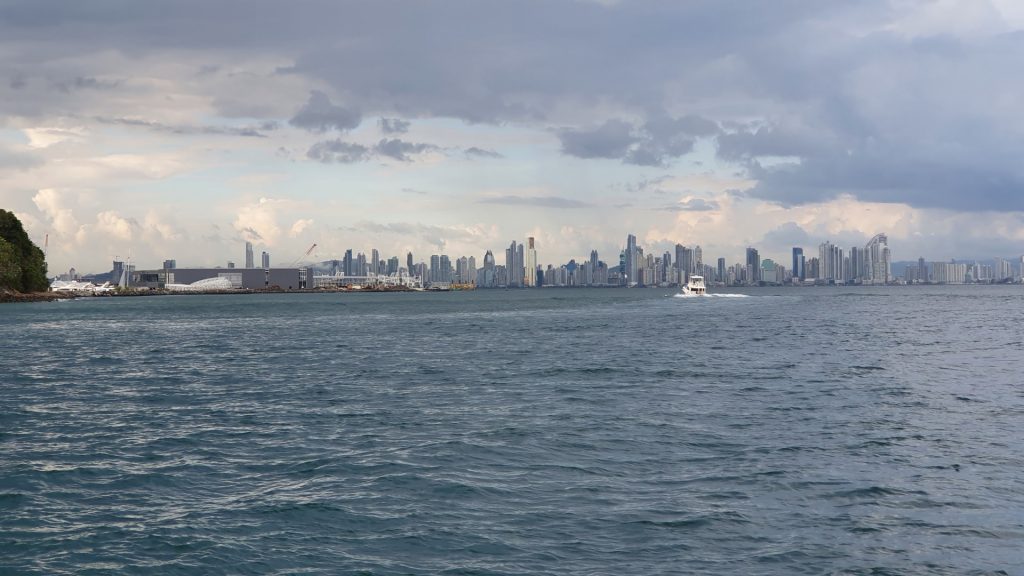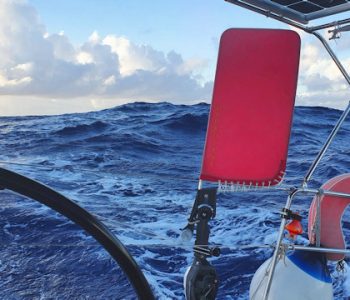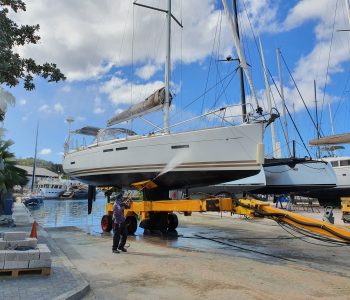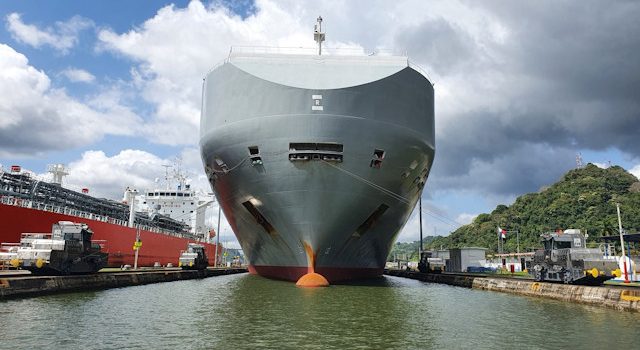 Allgemein
Allgemein
Through the Panama Canal
One of the most emotional moments of my trip, maybe even of my life, was crossing the Panama Canal. Even as a child I was enthusiastic about how large ships can be moved across a lake from one ocean to another. Back then in the GDR, I hadn’t even dared to dream of seeing it with my own eyes, let alone crossing it with my own sailing yacht. Now it became a reality.
Get Set Go
After the line handlers Tino, Eric and Guti reached the Aurelia very early, we had enough time for discussions, making pictures and last meetings with those who stayed a while in the Shelter Bay Marina. For my part, I was very happy that it would work before the turn of the year. In the meantime, parts of the New Year’s Eve lockdown are to be extended until mid-January.

We cast off punctually at 1 p.m. on December 28, 2020, sailed about a nautical mile towards the canal and initially anchored for two more hours until the pilot, or, more correctly, the advisor, came on board. That’s an important difference for the canal’s staff. The pilot has a higher education and is able to accompany the large ships of the Panamx and, since 2016, the NeoPanamax class through the canal. They are very familiar with the situations and procedures in the canal and give the captain all the necessary information. The latter retains the decision-making power, but it is better to listen to what the pilot recommends.

I was very happy with our advisor. He not only gave hints, but also explained the background. I can work well with that. It’s not only more interesting, you also can act better and faster if you know why you should do this or that.
To the first lock
At around 4 p.m. we lifted the anchor and went into the 150 m wide buoy line that led us directly to the first lock chamber. For the almost 6 nautical miles we needed almost two hours. The freighter ICE Rose driving in front of us went into the lock with us. So we had to adjust to its pace.


Ships kept coming towards us. The distance was less than 100m. On the high seas, I would be on high alert. Here it’s normal. Due to the low speed, there were no problems with suction or bow waves. A significant current can only occur in the lock.


26 meters upwards
At dusk we arrived at the first of the three lock chambers. After a few words of praise from the advisor, while we waited for the ICE Rose to be positioned correctly, we went inside. 4 canal workers walk with us along the wall and first throw thin, light lines with a monkey fist at the end onto our ship. They used to be filled with steel. So I was afraid for my solar roof. Today they are only knotted from ropes. In addition, as a skipper you can make things a little easier for the throwers by first approaching one wall and then the other. You shouldn’t overdo it, because it is not easy to get away if the radius of the rear end is larger than the distance to the wall. Everything went perfectly with us.
Once in the right position, the mooring lines are pulled ashore with the thin lines and attached to bollards. As soon as water flows into the lock chamber, the line handlers have to tighten the lines regularly and above all synchronously. Once at the top, the mooring lines are brought back on board. Up to the third chamber we remain connected to the mainland by the thin lines. The following video shows the essential steps, but greatly shortened and in time lapse. In fact, it takes just over 20 minutes per chamber.



One night in lake Gatun
After leaving the third chamber – of course it was raining again – we drove to a nearby mooring buoy. I’ve never seen a monster like this. It had a diameter of about 2.5 m and was made entirely of rubber. Shortly after 8:00 p.m. we tied to her on starboard.
After the advisor was picked up, Maya and Tino prepared a delicious dinner for us. Then we disappeared into our bunks rather tired. To minimize the risk of infection, we opened all hatches and spread out over the 3 cabins and the saloon couch. I contented myself with a mattress on the floor of the saloon.

29 miles freshwater
Next morning we were about to prepare breakfast when the new advisor came with an early appointment for the first lock in the direction of the Pacific. We had to leave immediately in order to reach the first chamber, 29 nautical miles away, in time.
Engine on, cooling water control, cast off!
At first I even forgot to turn on the satellite tracker, which you can use to follow me. At least there was still time to look back. A huge NeoPanamax class container ship was just sailing into the first of the new locks that were opened in 2016, heading for the Atlantic.

Then we passed our new lock partner, a car transport ship, whose name I have unfortunately forgotten. However, it was significantly larger than yesterday and later just fit into the lock chambers.
Now we had enough time to let our eyes and thoughts wander, despite the 6 knots of speed that demanded my engine at 2,700 rpm.
Eyes
First the eyes wandered along the natural shore lines. Later the human interventions became clearer.



The closer we got to the Pacific side, the higher the land became. Here you could see that a canal was being cut into the mountains. More than 100,000 workers were involved. More than one in five died.
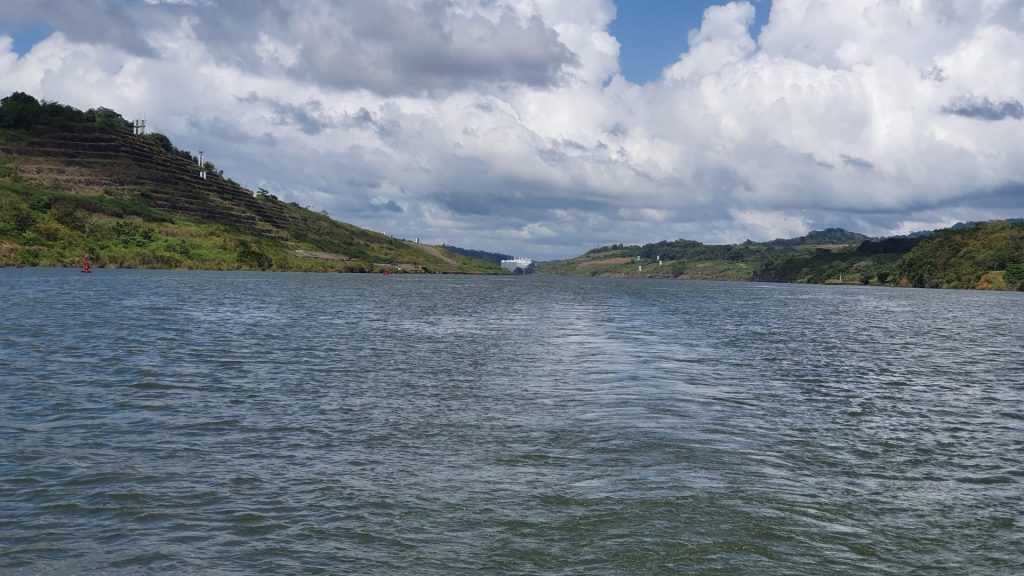



There are also hundreds of deaths during the US invasions. The last one took place in the shadow of German reunification.
Thoughts
Childhood dreams
I’m not sure when I first read or saw something on the Panama Canal. I was probably 10-12 years old and rummaged through the issues of the GDR magazine “Jugend + Technik” in my children’s room. Wanderlust was alien to me. The few 100km travel radius towards Poland, Czechoslovakia and Hungary were normal for me. I had my head. In it I put together the greatest things. Including cars that could overtake each other over the roof to avoid traffic jams, huge glass bells that protect biospheres from environmental pollution and other things. Thoughts are free! :-).
The idea of pulling ships through a canal with locomotives would never have occurred to me. Why don’t it jumps off the track when it pulls such a heavy ship? Where does all the water used by the locks come from? How can you dig in the water? I had a thousand questions, but no one to talk to about them. So I turned to more practical things. The canal and the many ideas were forgotten.

Fall of the (Berlin) Wall
Then came the German reunification. It was a basic requirement that you could at least dream of seeing the canal. Even if I didn’t think about the canal back then, now and here I relived the time of the fall of the Berlin Wall. The emotions surrounding the realization that we had gained more freedom than we could have imagined a few days earlier hit me with full force.
I was happy to be wearing sunglasses now. It would have been difficult to explain my wet eyes.
Circumnavigation
Finally, after the fall of the Berlin Wall, it took another 29 years until the crossing of the Panama Canal appears on my to-do-list as part of a circumnavigation. It was excatly on October 20, 2018, shortly before 5:00 a.m.

This was followed by 350 days of preparation and 6,000 nautical miles to Curacao. Then Covid19 came and everything was questioned again on the home stretch. There was only a small window between the first and second waves of participating countries. I used that to tackle the plans again.

26 meter downward
Around 1 pm, the first lock released me from my emotional roller-coaster-ride. Although we had to wait a while until the monster freighter catches up, there was enough to look and prepare. This time we went into the lock first. The freighter stopped right behind us – a queasy feeling. One wrong movement on his joystick and we are only crumbs at the lock gate. Of course that didn’t happen. Everything went smoothly. The obligatory rain shower overtook us in the third chamber, then the gates to the P A Z I F I K opened. Yippie-Ya-Yeah!




We past the mouth of a river that carried a lot of sediments before we stopped in front of a container port. Here the advisor left us. A little later we were at the Marina Balboa where the line handlers disembarked. Maya and I were alone on the ship again. Happy and relaxed we motored towards Flamingo Island, on the backside of which we wanted to anchor. Suddenly something big red built up in front of us. Because of the sheer relaxation I had completely forgotten that we were still sailing along the left edge of an buoyed channel. I saw the last buoy just in time.
A little later our anchor dropped in front of the impressive skyline of Panama City, right next to a small sailing boat full of seagulls and pelicans.
Despite temperatures above 25 degrees celsius, we were really cold and had meanwhile put on our sweaters. Rain and wind cooled us down quite a bit.



